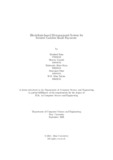| dc.contributor.advisor | Alam, Md. Golam Rabiul | |
| dc.contributor.author | Siam, Morshed | |
| dc.contributor.author | Mandal, Shovon | |
| dc.contributor.author | Keya, Mahmuda Akter | |
| dc.contributor.author | Dhar, Swarojani | |
| dc.contributor.author | Tahsin, H.M. Irfan | |
| dc.date.accessioned | 2022-06-06T06:19:10Z | |
| dc.date.available | 2022-06-06T06:19:10Z | |
| dc.date.copyright | 2021 | |
| dc.date.issued | 2021-09 | |
| dc.identifier.other | ID 17101253 | |
| dc.identifier.other | ID 18101142 | |
| dc.identifier.other | ID 18101414 | |
| dc.identifier.other | ID 18101145 | |
| dc.identifier.other | ID 18101515 | |
| dc.identifier.uri | http://hdl.handle.net/10361/16910 | |
| dc.description | This thesis is submitted in partial fulfillment of the requirements for the degree of Bachelor of Science in Computer Science and Engineering, 2021. | en_US |
| dc.description | Cataloged from PDF version of thesis. | |
| dc.description | Includes bibliographical references (pages 44-45). | |
| dc.description.abstract | The Internet of Things (IoT) is driving a tremendous digitization tsunami right
now. IoT devices create huge amounts of data in the internet of everything era.
Many IoT data services use distributed ledger technology like blockchains or IOTA.
The IOTA Foundation has completely has entirely redesign distributed ledger technology
to enable for secure cash and data exchange. It was intended to enable
fee-free micro-transactions in the growing IoT device network. It provides a scalable
network growth approach as well as transaction confirmations to enable smart
device micro-transactions. The quicker the network gets using the IOTA Tangle,
the more transactions are verified. IOTA currently has a maximum transaction
rate of roughly 7 transactions per second (TPS). The community network reached
a maximum of 600 confirmed Transactions Per Second in May 2020. (CTPS). We
propose a methodology for integrating Tangle into IoT blockchains in this article,
with Tangle serving as the backbone for all IoT devices. We will use two distinct
types of interfaces: web and NFC, and we will provide a solution to the message
overhead problem caused by message flooding. Also, we would want to present a
cost-cutting strategy that drastically cuts transaction time and storage for modest
payments. The results clearly reflect the efficacy and efficiency of our framework. | en_US |
| dc.description.statementofresponsibility | Morshed Siam | |
| dc.description.statementofresponsibility | Shovon Mandal | |
| dc.description.statementofresponsibility | Mahmuda Akter Keya | |
| dc.description.statementofresponsibility | Swarojani Dhar | |
| dc.description.statementofresponsibility | H.M. Irfan Tahsin | |
| dc.format.extent | 45 pages | |
| dc.language.iso | en | en_US |
| dc.publisher | Brac University | en_US |
| dc.rights | Brac University theses are protected by copyright. They may be viewed from this source for any purpose, but reproduction or distribution in any format is prohibited without written permission. | |
| dc.subject | IOTA | en_US |
| dc.subject | Blockchain | en_US |
| dc.subject | IoT | en_US |
| dc.subject | NFC- Near Field Communication | en_US |
| dc.subject | Q-learning | en_US |
| dc.subject | IOTA 2.0 DevNET | en_US |
| dc.subject.lcsh | Internet of things. | |
| dc.subject.lcsh | Cryptocurrencies | |
| dc.subject.lcsh | Blockchains (Databases) | |
| dc.title | Blockchain-based micropayment system for secured cashless small payments | en_US |
| dc.type | Thesis | en_US |
| dc.contributor.department | Department of Computer Science and Engineering, Brac University | |
| dc.description.degree | B. Computer Science | |

